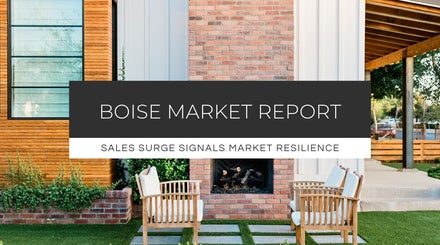
In November, Ada County home prices recorded their first year-over-year price decline since 2014.
On a month-to-month basis, home prices began falling in June but remained higher annually until now. The median home price in Ada County declined by 2.5% from last November. Prices in Canyon County eked out an annual gain of 1.4%.
Home prices have been under pressure this year as moves by the Federal Reserve to tame inflation have sent mortgage rates soaring.
Prices can rise and fall monthly, even when the overall price trend is higher (or lower). Many economists and real estate professionals focus on yearly comparisons to help smooth out that monthly volatility.
In the past few years, buyers saw the fall and winter months as an opportunity to get a leg up on the competition. This year, buyers and sellers are using the slow season to catch their breath and reassess.
House sales in Ada County fell 38.9% from a year earlier to 548, the lowest level since 2017.
Despite slowing demand, supply has been tightening. New home listings declined by 27% from last month and last year. The absence of new listings lowered inventory across the Treasure Valley.
In Ada County, months' supply of homes for sale declined for the second month to 2.56, the lowest level since spring. Supply in Canyon County dropped to 2.77, also the second decline in as many months.
At the current sales pace, the supply of homes for sale would be exhausted in just over two and a half months, well below the four or fewer months that is typically considered a seller's market.
In addition to fewer new listings, there has been a notable increase in the number of homes withdrawn from the market unsold. While there are always properties that fail to find buyers, inventory has been further reduced by sellers reconsidering their decision to sell in the first place.
With the steep increase in mortgage rates this year, many homeowners locked into lower rates are reluctant to give those up. Additionally, some potential sellers list their homes for rent rather than for sale, further reducing supply.
Median single-family home price and year-over-year change by area:
- Ada County: $525,000, down $13,450 (-2.5%)
- Canyon County: $415,000, up $5,550 (1.4%)
- Boise: $473,000, down $22,000 (-4.4%)
- Meridian: $524,900, down $25,100 (-4.6%)
- Eagle: $830,000, down $5,833 (-0.7%)
- Nampa: $399,990, up $490 (0.1%)
- Star: $537,054, down $17,941 (-3.2%)
Buyers Continue to Wait Out Volatile Mortgage Rates
Market fatigue, cooler-than-average temperatures, and the holidays have encouraged buyers and sellers to take a break and catch their collective breath. The result has been lower demand, a smaller home supply, and fewer sales.
With a demographic shift and a rekindled appreciation for suburban living, record-low mortgage rates were a significant driver of housing demand in 2020–21.
However, in 2022, that tailwind turned into a headwind as mortgage rates doubled, rising from 3.11% to 6.33%.
The fact that rates are higher than last year isn't the problem; today's rates are still lower than their long-term average. The issue is the speed of those rate increases and the accompanying volatility. This is only the third time in the last 50 years we have seen weekly moves of this magnitude. (The other two times were at the peak of the financial crisis in 2008 and the inflation shock of the early 1980s.)
Borrowers typically don't lock in their mortgage rate until they have signed a purchase agreement. Aside from facing higher financing costs, buyers have also had to deal with the added uncertainty of being unable to predict their monthly payments.
It's not just people borrowing to buy homes. All-cash transactions have declined at nearly the same rate as financed transactions.
The Pandemic Pulled Homebuyer Demand Forward
Some of the slowdown in buyer demand is due to rising interest rates. Another part is the return of seasonality—the annual trend of home prices climbing in the spring and dipping in the fall is as predictable as falling leaves and winter snow.
Even in 2019, before the pandemic began, supply was so low in the Treasure Valley that there wasn't a slow season; home prices rose year-round.
In addition to resulting in higher interest rates and a return to seasonality, the pandemic pulled some buyer demand forward.
Household formation was unusually high during the pandemic. Many millennials and first-time buyers, who may have otherwise been years away from homeownership, dove into an exuberant real estate market.
From first-time buyers to seasoned purchasers, the pandemic changed many people's priorities concerning their homes, and many looked for a better quality of life.
For the first time, it didn't matter where your employer was based; you could live anywhere you wanted to. Hybrid work schedules meant your commute was no longer the determining factor for where you chose to live.
Homeownership has always been part of the American dream. After the pandemic began, that dream grew to include more square footage—farther from neighbors—in a community that was more about quality of life than proximity to an employer's address.
In the Treasure Valley, locals and newcomers alike moved in record numbers, pushing up home prices by more than 60% in two years and pulling forward years of demand.
The Market Pause That Refreshes?
While it's not unusual to see a seasonal slowdown in the fall, what's happening in the Treasure Valley's housing market this year is different.
As you have probably noticed, the classic law of supply and demand seems out of sync right now, and it is.
It's very unusual to have falling prices amid a tightening supply. While inventory is much higher than 2021's record lows, the number of available homes for sale is low by historical standards, particularly compared to past slowdowns.
During the housing downturn of the late-2000s, price gains didn't reverse until supply had reached nearly eight months, three times the current level.
And it's not just supply; most market metrics align more with what we would typically see in a seller's market, yet prices are heading lower.
Over the longer term, low supply will put upward pressure on prices. But this year, interest rates have risen so fast that little else has mattered.
As we get closer to the traditional spring selling season, we will better understand how 2023 will play out.
If I had to guess, I would say real home values will likely continue to fall until mortgage rates level off. However, a shrinking supply will put a floor under prices, limiting the decline.
There are never guarantees, but if a purchase makes sense, now is a good time to be a buyer. You have negotiating power, more homes to choose from, and with few bidding wars, the time to consider your options and make the best decision.
Boise Real Estate Market Summary for November 2022
- Median list price - $485,000 (down 2.34%)
- Median sold price - $473,000 (down 4.44%)
- Price per square foot - $287 (down 2.05%)
- Total home sales - 215 (down 181)
- Median days on market - 28 days (up 13 days)
- Available homes for sale - 2.11 month supply (up 1.23)
- 30-year mortgage rates - 6.81% (up 3.83)
Boise Metro Housing Markets by Area
- Ada County - $525,000
- Eagle - $830,000
- Garden City - $675,000
- Kuna - $472,000
- Meridian - $524,900
- Star - $537,054
- Canyon County - $415,000
- Caldwell - $386,325
- Middleton - $535,000
- Nampa - $399,990
More From Our Blog
Information in this We Know Boise market report was obtained from the Intermountain MLS (IMLS) on December 7th, 2022. Deemed reliable but not guaranteed. City data refers to single-family homes on less than one acre, while county data includes homesites of all sizes. Current inventory is calculated on a twelve-month rolling average. Combining existing homes for sale with new construction is the best way to gauge current home prices and Boise housing market trends. New house prices are much more volatile and can create unreliable comparisons, particularly on a month-to-month basis.
Posted by Lisa Kohl on







Leave A Comment